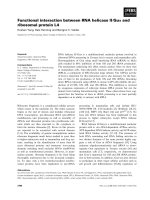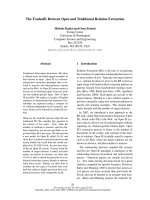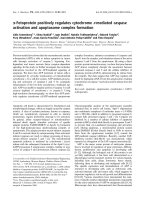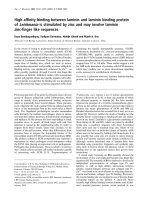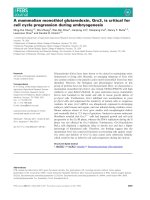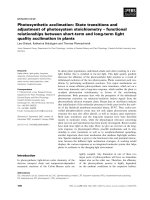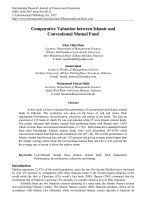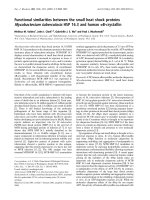Functional cooperation between FACT and MCM is coordinated with cell cycle and differential complex formation pot
Bạn đang xem bản rút gọn của tài liệu. Xem và tải ngay bản đầy đủ của tài liệu tại đây (1.93 MB, 11 trang )
Tan et al. Journal of Biomedical Science 2010, 17:11
/>The cost of publication in Journal of Biomedical Science
is bourne by the National Science Council, Taiwan.
Open Access
RESEARCH
© 2010 Tan et al; licensee BioMed Central Ltd. This is an Open Access article distributed under the terms of the Creative Commons At-
tribution License ( which permits unrestricted use, distribution, and reproduction in any
medium, provided the original work is properly cited.
Research
Functional cooperation between FACT and MCM is
coordinated with cell cycle and differential
complex formation
Bertrand Chin-Ming Tan*
†1
, Hsuan Liu
†1
, Chih-Li Lin
1
and Sheng-Chung Lee*
2,3
Abstract
Background: Functional cooperation between FACT and the MCM helicase complex constitutes an integral step
during DNA replication initiation. However, mode of regulation that underlies the proper functional interaction of FACT
and MCM is poorly understood.
Methods & Results: Here we present evidence indicating that such interaction is coordinated with cell cycle
progression and differential complex formation. We first demonstrate the existence of two distinct FACT-MCM
subassemblies, FACT-MCM2/4/6/7 and FACT-MCM2/3/4/5. Both complexes possess DNA unwinding activity and are
subject to cell cycle-dependent enzymatic regulation. Interestingly, analysis of functional attributes further suggests
that they act at distinct, and possibly sequential, steps during origin establishment and replication initiation. Moreover,
we show that the phosphorylation profile of the FACT-associated MCM4 undergoes a cell cycle-dependent change,
which is directly correlated with the catalytic activity of the FACT-MCM helicase complexes. Finally, at the quaternary
structure level, physical interaction between FACT and MCM complexes is generally dependent on persistent cell cycle
and further stabilized upon S phase entry. Cessation of mitotic cycle destabilizes the complex formation and likely
leads to compromised coordination and activities.
Conclusions: Together, our results correlate FACT-MCM functionally and temporally with S phase and DNA replication.
They further demonstrate that enzymatic activities intrinsically important for DNA replication are tightly controlled at
various levels, thereby ensuring proper progression of, as well as exit from, the cell cycle and ultimately euploid gene
balance.
Background
Complete and precise DNA replication is essential to the
maintenance of genomic integrity and balance. Initiation
is the most critical regulatory step, which coincides with
the onset of S phase and requires prior assembly of pre-
replicative complexes (preRCs). Reinitiation of DNA rep-
lication is usually prevented, and only a single round of
DNA duplication is performed in a cell cycle. Such
restriction mechanism, called replication licensing, partly
lies in the regulation of preRC assembly. The protein
components of the preRC complex include origin recog-
nition complex (ORC), Cdc6, Cdt1 and minichromosome
maintenance proteins (MCM2-7). Phosphorylation of
components of the assembled pre-RC constitutes a sec-
ond level of initiation regulation, upon which the initia-
tion of DNA replication is triggered at the G
1
-S boundary
[1-3]. Finally, as with the formation of pre-RC, the transi-
tion to DNA replication involves the association of addi-
tional replication factors that facilitate unwinding of the
origin DNA, as well as multiple DNA polymerases [4].
Following origin activation, new DNA synthesis begins as
replication forks move away from the initiation region
[1,5,6].
Among different replication factors, the hexameric
helicase complex MCM provides an essential activity, cat-
alyzing the unwinding of DNA duplex [7]. Previous work
has established a direct role of MCM in not only the initi-
ation step, but also the elongation stage of DNA replica-
* Correspondence: ,
1
Department of Life Science, College of Medicine, Chang Gung Univeristy,
Taoyuan, Taiwan
2
Institute of Molecular Medicine, College of Medicine, National Taiwan
University, Taipei, Taiwan
†
Contributed equally
Tan et al. Journal of Biomedical Science 2010, 17:11
/>Page 2 of 11
tion [4,8]. MCM possesses various functional features
that are coordinated with other events of the cell cycle
[1,7]. Consistent with its functional significance, several
regulatory mechanisms have been uncovered that serve
to preserve and restrict its proper activities [9]. Phospho-
rylation accounts for a major regulation. Activation of the
MCM complex requires the actions of both the CDC7/
DBF4 and cyclin-dependent kinases [1,2]. Mitotic and
DNA damage-induced phosphorylation of the MCM4
subunit, concomitant with loss of activity and/or subcel-
lular localization change, involves CDK2-cyclin A or
cyclin B [10-14]. Another mode of regulation lies in the
combinatorial formation of MCM subassemblies. Aside
from the expected heterohexameric complex (MCM2/3/
4/5/6/7), in vitro experiments have demonstrated the for-
mation of several stable subassemblies including MCM2/
4/6/7, MCM4/6/7, and MCM3/5 complexes [15-18].
Among them, a weakly processive DNA helicase activity
was identified in the MCM4/6/7 complexes of human,
mouse, and fission yeast, whereas the heterohexamer
lacks such activity [15,16,19,20]. Work done by Schwacha
and Bell further discriminated two functionally distinct
MCM protein subgroups: the "catalytic core" MCM4/6/7
and the "regulatory" MCM2p, 3p, 5p [21]. These results
suggest that distinct assemblies of MCM subunits may
contribute optimally to the coordinated and differential
actions during the progression of replication.
Chromatin poses yet another type of regulation of the
MCM activity, and the progression of replication in gen-
eral, in an inhibitory fashion [1,22]. Various reports have
shown that local chromatin environment, as well as chro-
matin remodeling factors, directly dictates activity of the
replication origin and DNA replication [23-28]. As dem-
onstrated by our recent work, nucleosomes impose a
structural hindrance that efficiently reduces the DNA
helicase activity of MCM [29]. Functional interaction
between MCM and the FACT heterodimeric complex,
however, alleviates such inhibition and concomitantly
facilitates chromatin DNA unwinding. Our findings,
together with those from other groups, show that the
FACT-MCM complex plays an important role in the nor-
mal progression of DNA replication initiation and S
phase in vivo [29-31]. Mode of regulation for this essen-
tial chromatin unwinding activity has not been character-
ized presently.
In this study we present several lines of evidence link-
ing the functions of the FACT-MCM complex to cell
cycle progression and regulation. Functional attributes
such as origin association, DNA unwinding activities, and
complex formation are intimately coordinated with cell
cycle progression. Furthermore, the FACT-MCM inter-
action is generally dependent on persistent cell cycle and
cell proliferation. These results suggest that the FACT-
MCM complexes are tightly controlled at various levels to
safeguard its essential activity as well as precise DNA syn-
thesis.
Methods
Antibodies and Western blot analysis
Generation of monoclonal antibodies against SSRP1
(2B12/control, 10D1, and 10D7) and hSpt16p (8D2) was
described previously [32]. Anti-human ORC1 monoclo-
nal antibody was purchased from NeoMarker/Lab Vision.
Polyclonal serum against human pan-MCM was pur-
chased from BD biosciences. Monoclonal antibody
against Cdc6 and rabbit antisera against MCM3, MCM4,
MCM5, and MCM6 were produced with the following
peptide antigens and affinity purified by Dagene (Tai-
wan). Cdc6: MCM3: SDTEEEMPQVHTPKTAD; MCM4:
SRRGRATPAQTPRSED; MCM5: KEVADEVTRPRPSGE;
MCM6: KYLQLAEELIRPERNT. Polyclonal antibody
against MCM2 was generated using a recombinant pro-
tein fragment of MCM2 (a.a. 792-892). Monoclonal anti-
body against Cdc45 (E-3) was purchased from Santa Cruz
Biotechnology. Anti-FLAG mAb (M2) was purchased
from Sigma. Western blot analysis was performed after
electrophoretic separation of polypeptides by 7.5% or
10% SDS-PAGE and transfer to Hybond-C membranes.
Blots were probed with the indicated primary and appro-
priate secondary antibodies, and detected by ECL chemi-
luminescence (Amersham).
Immunoprecipitation
HeLa or K562 cells were extracted using a buffer contain-
ing: 20 mM HEPES (pH 7.4), 0.2 M NaCl, 0.5% TX100, 5%
glycerol, 1 mM EDTA, 1 mM EGTA, 10 mM β-glycero-
phosphate, 2 mM Na
3
VO
4
, 1 mM NaF, 1 mM DTT, plus
protease inhibitors. For preparation of nuclear extracts,
HeLa nuclei were isolated and lysed in nuclear extraction
buffer (10 mM HEPES with pH 7.9, 10 mM KCl, 0.1 mM
EDTA, 0.1 mM EGTA, 0.1% TX-100, 0.4 M NaCl, 10%
glycerol and protease inhibitors). All immunoprecipita-
tions were done with the indicated antibodies prebound
to protein G-Sepharose (Amersham), and washed in the
cell lysis buffer.
Gel-filtration fractionation
Gel filtration chromatography was done using a precali-
brated Sephacryl S-400 HR column with a bed volume of
135 ml (Pharmacia). Nuclear lysate preparation, chro-
matographic settings, and fraction collection and pro-
cessing were done essentially as reported previously [32].
Cell culture and cell cycle analysis
All HeLa cells were maintained in Dulbecco's modified
Eagle's medium supplemented with 10% fetal bovine
serum and 100 units/ml penicillin and streptomycin.
Cells were transfected using Lipofectamine (GIBCO)
Tan et al. Journal of Biomedical Science 2010, 17:11
/>Page 3 of 11
according to the manufacturer's instructions. For moni-
toring cell cycle progression and immunostaining analy-
sis, collection of HeLa cells at different stages of the cell
cycle was achieved by the mitotic shake-off or the double
thymidine block method, as outlined previously [32]. Pro-
cedure for the FACS analysis was also described in the
same report. Early G
1
cells were collected by replating
mitotic cells and allowing attachment for 2-4 hrs. To
achieve a differentiation (or resting) phase in K562 cells,
cells were subjected to 3-day treatment of 2 mM sodium
butyrate [33].
Plasmid-based dsRNAi
To establish a plasmid-based dsRNAi system targeting
endogenous MCM3 or MCM4, annealed oligonucle-
otides corresponding to partial sequence were designed
and ligated to the pSuper.neo+GFP (OligoEngine)
according to the manufacturer's instructions. The cDNA
sequence of the targeted mRNA region for different
genes is as follows. MCM3: 5'-AAACGAGAAGAG-
GGCTAAC-3' (nucleotides 171-189); MCM4: 5'-
GACACCACACACAGTTATC-3' (nucleotides 1095-
1113). The same sequence in the inverted orientation was
used as the non-specific dsRNAi control.
Indirect immunofluorescence and confocal microscopy
All steps of the immunostaining procedure were essen-
tially identical to a previous report [32]. Subsequent to
staining with the indicated primary antibodies, secondary
antibody incubation was done for 1 h using Alexa 488
conjugated goat anti-mouse IgG and Alexa Fluor 594
conjugated goat anti-rabbit IgG (Moleular Probes, Inc).
To visualize DNA, cells were counter-stained with DAPI.
Stained cells were analyzed with the Zeiss LSM-510
inverted confocal laser-scanning microscope, using a
100X/NA 1.4 oil immersion or 40× objective lens.
DNA helicase assay
The substrate for the helicase assay was a partially hetero-
duplex DNA containing a 17-mer oligonuleotide (5'-
GTTTTCCCAGTCACGAC-3') annealed to the
M13mp18 (+) circular ssDNA (Amersham). Before
annealing, the oligonuleotide was labeled at the 5' end
with [γ-
32
P]ATP by polynucleotide kinase. The annealed
substrate was subsequently purified on the MicroSpin
G50 column (Amersham). MCM-containing FACT
immunocomplexes were isolated by the indicated anti-
bodies and from HeLa cells at the specified cell cycle
stages. With the exception of the immobilized source of
enzymatic activities, DNA helicase assay was performed
essentially as described previously [34], with the addition
of approximately 10-20 fmol of substrate. After depro-
teination, samples were resolved by electrophoresis (15%
native PAGE/TBE) and autoradiographed.
Chromatin immunoprecipitation
Chromatin immunoprecipitation assays were modified
from previously described methods [35]. Briefly, HeLa
cells (exponentially growing or synchronized) were cross-
linked with 1% formaldehyde for 10 min at 37°C. The
nuclei were isolated and sonicated into oligonucleosomes
of ~500-600 bp in length. The sheared chromatin was
immunoprecipitated overnight with protein G-agarose
previously bound with the 10D1, 8D2, or control anti-
body. After extensive washes, the immunoprecipitates
were subjected to deproteination and cross-linking rever-
sal. The presence of genomic DNA in the precipitates was
detected by PCR with the B48 primer set and a back-
ground primer set. The background primers anneal to a
region with no annotated genes, 30 kb upstream of the
lamine B2 origin sequence on chromosome 19, and have
the following sequences: 5'-CTATGCCAAGCCCAT-
TCTAGGTCCT-3 (sense); 5'-GCAGGGAAACTGTG-
CACAGCAAGAG-3' (antisense). Upon amplification for
27-30 cycles, the products were resolved by 2% agarose
gels and visualized with ethidium bromide staining. UV-
illuminated images were photographed and analyzed by
AlphaImager 1220 (Alpha Innotech Corp.)
Results
Subassemblies of MCM form distinct complexes with FACT
heterodimer
Our previous work on the transcription elongator FACT
has identified and characterized the physical and func-
tional interaction between FACT and a subassembly of
the MCM helicase complex, namely MCM2/4/6/7 [29].
To carry out a more thorough examination of FACT-
associated complexes, we performed additional Western
analysis on different anti-FACT immunoprecipitates iso-
lated from whole cell (Figure 1A, left panel) and nuclear
extracts (right panel). The specificity of these antibodies
was demonstrated by the lack of cross-reactivity to MCM
proteins (Additional file 1 Figure S1A). Intriguingly, by
using different antibodies that recognize pan or individ-
ual MCM subunits, we discovered that distinct subsets of
MCM proteins are associated with the anti-hSpt16p
(8D2) or anti-SSRP1 (10D1) precipitates (as summarized
in a chart in Figure 1A, bottom right panel). Whereas
both MCM2 and MCM4 are commonly shared between
these two types of complexes, differential coprecipitation
of MCM3/5 (by 8D2) and MCM6/7 (by 10D1) was
observed (Figure 1A). These results demonstrate that
FACT may interact with discrete subcomplexes of the
MCM proteins.
The primary biochemical activity of the MCM complex
is the unwinding of the DNA strands [15,19]. Thus, to
examine whether the identified MCM-associated FACT
complexes are catalytically active, we performed DNA
helicase assay. Immunoprecipitates were incubated with
Tan et al. Journal of Biomedical Science 2010, 17:11
/>Page 4 of 11
labeled substrate and their abilities to displace annealed
oligonucleotide were assayed. We found that, as com-
pared to the control antibody, FACT complexes precipi-
tated by either 8D2 or 10D1 antibody possessed DNA
helicase activity (Figure 1B). This suggests that the two
distinct FACT immunocomplexes, although differing in
MCM constituents, are both competent in unwinding
DNA in vitro. Furthermore, such catalysis is an ATP-
dependent process, as no such activity was detected in
the absence of ATP, nor in the presence of nonhydrolyz-
able form of ATP (Figure 1C).
To further characterize whether the DNA helicase
activity displayed by the FACT immunocomplexes is
mediated through the associated MCM complex, we iso-
lated from MCM4
RNAi
cells (Additional file 1 Figure S1B)
the 10D1 immunoprecipitates that are deficient in the
MCM complex and found that the DNA helicase activity
was greatly reduced (Figure 1D). This reduction was not
observed in the 10D1 immunoprecipitates isolated from
control or MCM3
RNAi
cells (Additional file 1 S1B) in
which the FACT-MCM association is still present. This
result serves as strong evidence that the helicase activity
of the 10D1 immunocomplexes can be attributed primar-
ily to the associated MCM complex, but not any non-spe-
cifically associated activities.
Next, we subjected HeLa nuclear extracts (Figure 1A)
to gel filtration to further verify the presence of FACT-
MCM complexes. As shown by Western blot, both FACT
and MCM subunits have broad and overlapping distribu-
tions in fractions ranging in molecular size from 669 kDa
to 2 MDa (Figure 2). To further distinguish the physical
association between the FACT and MCM subcomplexes,
we subjected gel filtration fractions to immunoprecipita-
tion. Presence of the MCM subunits in the precipitates
isolated by the two antibodies (8D2 and 10D1) from frac-
tions 8-32 confirms the coelution of these two complexes
and suggests that they combine to form complexes of var-
ious sizes (Figure 2). Furthermore, this immunoprecipita-
tion assay approximately resolved three different peaks of
MCM copurification (Figure 2, lower section). Interest-
ingly, we could observe a shift in peak elution between
peak 2 (10D1) and peak 3 (8D2), indicating a difference in
the apparent sizes of FACT-MCM2/4/6/7 and FACT-
MCM2/3/4/5. The MCM constituents of these immuno-
complexes, as shown by Western blot, are consistent with
the above immunoprecipitation experiments that
detected two separate types of FACT-MCM association
(Figure 1A). Together, these observations strongly cor-
roborate the existence of two distinct FACT-MCM sub-
complexes. The true identity of the immunocomplexes in
peak 1 fractions cannot be deduced by our experiment. In
summary, our biochemical analyses definitely character-
ize two native, enzymatically active FACT-MCM com-
plexes that contain either the MCM2/4/6/7p or the
MCM2/3/4/5p subassembly with the common partner
FACT. Our results do not preclude, however, the exis-
tence of additional, higher molecular-weight FACT-
MCM complexes (in the MDa range) that might include
other interacting polypeptides or DNA.
Figure 1 Subassemblies of MCMs form distinct, DNA unwinding-
competent complexes with FACT. (A) Western blot analysis of HeLa
whole cell extracts (left panel) and nuclear extracts (right panel), as well
as the different immunocomplexes targeted by control (2B12), α
hSpt16p (8D2), and α SSRP1 (10D1) mAbs. Immunoblotting was done
using the indicated antibodies against pan-MCM or individual sub-
units. The amount of the Input is equivalent to 1/40 the IP. The identity
of the protein band, marked by the asterisk, is unknown. The chart
summarizes the constituents of the different FACT immunocomplexes.
(B) Immunocomplexes were isolated as in (A) and subjected to DNA
helicase assay. The reaction was conducted on a radiolabeled, 17-mer
oligonucelotide annealed on the M13 single-stranded DNA ("HD", het-
eroduplex DNA). Upon protein removal, reaction mixtures were re-
solved by native gel. The locations of the annealed and displaced
(ssDNA) substrates on the gel are shown. Displacement of the an-
nealed substrate by heat denaturation is also shown (Boiled). (C) The
DNA helicase activity of the FACT-MCM complex is ATP-dependent.
The displacement of 17-mer oligonucleotide (SS) from the heterodu-
plex substrate (HD) by the 10D1-immunocomplex was assayed in the
presence (lane 2) or absence (lane 3) of ATP, or in the presence of ATP-
γ S (lane 4). (D) HeLa cell extracts were prepared from control (lanes 2
& 3), MCM4
RNAi
(lane 4), or MCM3
RNAi
(lane 5) cells. The displacement ac-
tivity of the mock- (lane 2) or 10D1- (lanes 3-5) immunocomplex isolat-
ed from these extracts is shown.
Tan et al. Journal of Biomedical Science 2010, 17:11
/>Page 5 of 11
Functional attributes of the two distinct FACT-MCM sub-
complexes
Both FACT-MCM immunocomplexes are equally active
in unwinding DNA template, indicating that their distinc-
tion may lie in other functional aspect. Thus, to further
delineate and discriminate the functional attributes of the
FACT-MCM complexes, we first sought to probe for the
potential association of other pre-replication complex
(pre-RC) factor. To this end, we performed co-immuno-
precipitation experiments using the 8D2 and 10D1 anti-
bodies. Endogenous ORC1 and Cdc6 were detected in
the 8D2 immunocomplexes (Figure 3A). On the other
hand, ORC was absent and the signal of Cdc6 was weak in
the 10D1 immunoprecipitates. Such preferential associa-
tion of the FACT-MCM2/3/4/5 complex with the origin-
bound pre-RC may imply its role during pre-RC assem-
bly. We also probed for the presence of Cdc45, which is a
component of the large replisome progression complex
(RPCs) that also includes MCMs and FACT [31]. Inter-
estingly, we were able to detect this factor in both immu-
nocomplexes (Figure 3A), suggesting that identified
FACT complexes may be associated with active replica-
tion.
To further evaluate the replicative role of these sub-
complexes, we examined their origin association. In our
previous work, we discovered that the 10D1-targeted
Figure 3 Functional attributes of the two distinct FACT-MCM as-
semblies. (A) HeLa WCE was subjected to immunoprecipitation with a
control (lane 2), 8D2 (lane 3), or 10D1 (lane 4) antibody. Lane 1 is the
extract input for the IP (1/40). Existence of pre-RC components (ORC1
and Cdc6) and Cdc45 in these immunoprecipitates was detected by
specific antibodies. (B) ChIP was performed as described in Methods.
Sonicated chromatin fragments were prepared from cells at different
stages: asynchronous (lanes 1, 4, 7 & 10), G
1
/S (lanes 2, 5, 8 & 11), and
G
2
/M (lanes 3, 6, 9 & 12). Immunoprecipitation was done with either
control (IgG, lanes 7-9), 8D2 (lanes 4-6, 10-12), or 10D1 (lanes 1-3) anti-
body. Products from final PCR analysis using primers specific to lamin
B2 origin (lanes 1-9) or to a non-transcribed region (lanes 10-12) were
resolved by 1.5% agarose gel. Precipitated products are shown in the
upper panels, DNA input in the lower. (C) Degree of origin association
of the two immunocomplexes was quantitatively determined by the
normalized ratio of amplified origin sequence, with the ratio of the
asynchronous immunoprecipitate represented as 1. The histograms
summarize such calculation and compares the origin binding of the
FACT immunocomplex (8D2, left; 10D1, right) at each cell cycle stage.
Data are averaged ± standard deviations of three independent exper-
iments. (D) ChIP was performed as in (B). Sonicated chromatin frag-
ments were prepared from control, MCM3
RNAi
, and MCM4
RNAi
cells
(HeLa). Immunoprecipitation was done with either 8D2 (top panel) or
10D1 (middle panel) antibody. Presence of origin fragment was de-
tected by PCR. PCR products from input DNA are shown in the bottom.
Figure 2 Fractionation profile of distinct FACT-MCM complexes.
HeLa nuclear extracts (Figure 1A) were subjected to gel filtration chro-
matography using Sephacryl S-400. Generated fractions (numbers as
indicated) were immuno-probed with the specified antibodies. Select-
ed fractions were further subjected to immunoprecipitation using
10D1 and 8D2, and subsequently probed with the indicated antibod-
ies. Peaks 1, 2, and 3, as shown in the 10D1 IP and 8D2 IP panels, denote
the approximate fractions in which copurification of MCM with FACT
was observed.
Tan et al. Journal of Biomedical Science 2010, 17:11
/>Page 6 of 11
FACT complex is present in vivo at a region of known
replication origin, namely the replicator associated with
the human lamin B2 gene. Using the ChIP assay, chroma-
tin prepared from cells synchronized at different cell
cycle stages was precipitated with the 8D2 or 10D1 anti-
body (Figure 3B). PCR reactions using specific sets of
primers were subsequently performed to monitor the
existence of the lamin B2 origin sequence (Figure 3B,
lanes 1-9). As shown in Figure 3B, at equal loads of chro-
matin preparations, we observed specific occupancy of
8D2-targeted FACT complex in the ori region in asyn-
chronously growing cells (compare lanes 4 and 7). As a
control, sequence of a distant non-transcribed region
(Figure 3B, lanes 10-12, see Methods) was not enriched in
the immunoprecipitates. Furthermore, no origin binding
of either immunocomplexes could be detected in mitotic
cells (lanes 3 and 6, and ref. 28). This result is reminiscent
of the observed dissociation of FACT from condensed
chromatin during mitosis [32]. Interestingly, while the
10D1-complex exhibited an enrichment of such origin
binding during the transition from G
1
to S phase (com-
pare lanes 1 and 2; Figure 3C, histogram on the right), the
8D2-associated complex seemed to display a relatively
greater degree of association in G1 as compared to the
point entering S phase (lanes 4 and 5; Figure 3C, histo-
gram on the left). These results reflect the activity of both
FACT-MCM complexes locally at origins or replication
forks, and imply their differential origin association.
Next, to further delineate the differential origin binding
modes of the two FACT-MCM immunocomplexes, we
performed additional ChIP assays on MCM3
RNAi
or
MCM4
RNAi
cells. Chromatin preparations from these two
cell lines were subjected to ChIP using either the 8D2 or
10D1 antibody and probed for the presence of the lamin
B2 origin sequence (Figure 3D). In the context of down-
regulated MCM3 or MCM4 protein level, association of
the 8D2 immunocomplex with the origin was disrupted
(Figure 3D, middle panel). This signals that the origin
binding of FACT (and the FACT-MCM2/3/4/5) lies, at
least in part, in the presence of an intact MCM2/3/4/5
complex. Furthermore, in the MCM4
RNAi
cells, we saw a
similar reduction of the origin fragment in the 10D1
immunocomplex, demonstrating the importance of
MCM4 in this functional regard (top panel). Intriguingly,
knockdown of the MCM3 subunit unexpectedly led to a
weakened association of FACT-MCM2/4/6/7 with lamin
B2 origin. A likely explanation for this phenomenon is
that the origin association of the MCM3-associated com-
plexes (including FACT-MCM2/3/4/5) may be preceding
and required for the subsequent recruitment of FACT-
MCM2/4/6/7. Therefore, there may exist two different
temporal modes through which the FACT-MCM com-
plexes are recruited to the replicator (see Discussion).
Collectively, results presented in Figure 3 suggest that
these two FACT-MCM complexes may operate at distinct
stages during the initiation phase of DNA replication.
Functional regulation of the FACT-MCM complex mirrors
cell cycle progression
While probing for the presence of MCM4 in the anti-
FACT immunocomplexes, we observed smear of immu-
noreactive signals representative of multiple lower-
mobility protein forms (Figures 1A &4A). Changes in
electrophoretic mobility of MCM4 may potentially be
induced by phosphorylation, as demonstrated previously
[11]. Indeed, treatment of the immunoprecipitates with
alkaline phosphatase eliminated the higher protein forms
(Figure 4A, compare lanes 5 and 6). However, no
phophatase-induced electrophoretic mobility change was
seen in the other MCM subunits, implying their lack of
modification by phosphate-moiety (Figure 4A, lanes 1-4).
Importantly, other groups have reported that, in logarith-
mically growing or S phase HeLa cells, lower mobility
form of MCM4 could be detected largely in the chroma-
tin fraction but not in the Triton-soluble fraction [13,14].
Our results therefore suggest that the isolated FACT-
MCM complex is likely to exist endogenously in a chro-
matin-bound form.
Based on the previous observation that mouse MCM4
undergoes mitotic hyper-phosphorylation and functional
inactivation [11], we wanted to examine whether the
FACT-associated MCM4 (and MCM complex) is simi-
larly modulated in a cell cycle-dependent manner (Addi-
tional file 1 Figure S1C). First, at the post-translational
modification level, lower-mobility forms of FACT-bound
MCM4 became increasingly visible starting in G
2
phase
and peaking in M phase, during which the unmodified
form was only marginally present (Figure 4B, middle two
panels). While the degree of phosphorylation of MCM4
altered, the profiles of the FACT dimers and the associ-
ated MCM subunits remain relatively invariable across
cell cycle (Figure 4B, upper two panels). Second, to
address whether this alteration in modification status of
MCM4 reflects cell cycle-dependent functional changes
for the FACT-MCM complex, we performed DNA heli-
case assay on immunoprecipitates isolated from different
stages (Figure 5A). We found that, at the equivalent levels
of co-precipitated MCMs (Additional file Figure S1D),
the DNA unwinding activity of either the 8D2 or 10D1
immunocomplex peaked at the G
1
/S junction (Figure 5A).
However, both FACT-MCM complexes exhibited signifi-
cantly lower helicase activity during G
2
and mitosis, simi-
larly to the cell cycle regulation of the core MCM helicase
activity [11]. Taken together, our observations are in
agreement with the previous results on mouse MCM4.
Therefore, we conclude based on these data that the asso-
ciation of FACT with the MCM complex preserves MCM
Tan et al. Journal of Biomedical Science 2010, 17:11
/>Page 7 of 11
helicase activity and its temporal regulation during cell
cycle progression.
Further evidence that links the possible role of FACT-
MCM to S phase was obtained from immunofluores-
cence analysis. While examining the subcellular localiza-
tions of these two factors at different cell cycle stages, we
found a discernible degree of colocalization between
FACT and MCM4 at G
1
/S junction as well as throughout
S phase (Figure 5B). However, this colocalization was
markedly reduced in early G
1
(Figure 5B) or G
2
/M cells
(data not shown). Such manner of interaction between
complexes may contribute to their coordinated functions
during S phase.
Cell proliferation underlies the interaction between FACT
and MCM
Near lack of overlapping signals between FACT and
MCM at the G
0
/early G
1
stage of cell cycle led to the spec-
ulation that the FACT-MCM interaction may be posi-
tively regulated by cell proliferation. To entertain this
possibility, we examined the FACT-MCM complex for-
mation in quiescent cells. Interestingly, consistent with
the localization data, we detected less MCM proteins
(~45% of control) in the FACT immunoprecipitates in
K562 cells upon entry into a differentiation/G
0
-like state
(induced by treatment with sodium butyrate). This sug-
gests that the formation/disruption of the FACT-MCM
complex is correlated with cell proliferation (Figure 6).
Discussion
In this report, we provide several lines of evidence
describing that cell cycle-associated signaling that gov-
erns normal S phase progression accounts for a major
regulatory mechanism for the functional interaction
between FACT and MCM complexes. We demonstrate
that, during the period following pre-RC assembly and
continuing into S phase, origin recruitment and function
of the two types of complex is distinct. Furthermore, we
show that the phosphorylation profile of the FACT-asso-
ciated MCM4 undergoes a cell cycle-dependent change,
which is directly correlated with the catalytic activity of
the FACT-MCM helicase complex. At the quaternary
structure level, physical interaction between FACT and
MCM complexes is generally dependent on persistent cell
cycle and further stabilized upon S phase entry. Thus, like
the other proteins essential for DNA synthesis, the
FACT-MCM-associated chromatin unwinding activity is
tightly controlled at various levels by the cell cycle regula-
tion (Figure 7B). Proper function, as well as timely down-
regulation, of these complexes is necessary for maintain-
ing once-per-cycle DNA replication and euploid gene
balance.
We made an interesting and novel finding of the exis-
tence of multiple assemblies of the FACT-MCM complex:
Figure 4 FACT-associated MCM4 undergoes a cell cycle-depen-
dent phosphorylation change. (A) HeLa cells were immunoprecipi-
tated with mAb 8D2 (lanes 1 and 2) and 10D1 (lanes 3-6).
Immunoprecipitates were further subjected to buffer (lanes 1, 3, and 5)
or alkaline phosphatase treatment (lanes 2, 4, and 6). The presence of
MCM proteins was detected by Western blot analysis using anti-pan
MCM (lanes 1-4) and α MCM4 (lanes 5 and 6) antibodies. The positions
of MCM 3/4/6 are distinguished by arrowheads. The smear of immuno-
reactive signlas for MCM4 is also highlighted. (B) FACT-associated im-
munocomplex was isolated by α SSRP1 mAb 10D1 from HeLa cells at
different cell cycle stages: exponentially growing (lane 1), G
1
/S phase
(lane 2), S phase at 1 hr after double-thymidine block (lane 3), S phase
at 3 hr (lane 4), and M phase (lane 5) and G
2
(lane 6). The presence of
MCMs and FACT heterodimers was detected by the specified antibod-
ies. The top four panels are immunoblots for the immunoprecipitates,
and the bottom two panels are for the lysate inputs. The two anti-
Mcm4 blots are from different exposure lengths of signal development
(longer exposure on top).
Tan et al. Journal of Biomedical Science 2010, 17:11
/>Page 8 of 11
F
Figure 5 Catalysis and formation of the FACT-MCM complex is regulated in a cell cycle-dependent manner. (A) FACT-associated immunocom-
plexes were isolated by mAbs 10D1 (left panel) and 8D2 (right panel) from HeLa cells at different cell cycle stages: exponentially growing (As), G
1
/S
phase, and M phase and G
2
. The immunoprecipitate was subsequently subjected to DNA helicase assay as in Figure 1B. Displacement of the annealed
substrate by heat denaturation is also shown ("B"). (B) Indirect immunofluorescence analysis was performed on HeLa cells to observe localization of
endogenous MCM4 and SSRP1 using the respective antibodies. Nuclear DNA was counter-stained by DAPI. Cells in indicated phases of the cell cycle
were examined: early G
1
, G
1
/S, mid- and late- S phase (cells at 2 and 4 hours after G
1
/S release, respectively). Images were generated by laser scanning
confocal microscopy.
Tan et al. Journal of Biomedical Science 2010, 17:11
/>Page 9 of 11
ACT-MCM2/4/6/7 and FACT-MCM2/3/4/5. Based on
the previous observations on the stable formation of dif-
ferent subassemblies among the six MCM subunits [15-
17,21], we initially postulated that the identified FACT-
MCM2/3/4/5 complex may serve as a regulator to the
presumably "catalytic" assembly of FACT-MCM2/4/6/7.
However, we subsequently detected DNA unwinding
activities in both of the immunocomplexes. Despite this
discrepancy, which may be attributed to the intrinsic dif-
ference between the endogenous (as in FACT-MCM) and
the reconstituted complexes, the true architecture as well
as the catalytic properties of the MCM complexes in the
cellular context is still largely unknown. The existence of
multiple DNA helicase subcomplexes (or the FACT-
MCM subcomplexes) has several explanations. First, cer-
tain subcomplexes still may serve as regulators to other
catalytic counterparts in the cell, as proposed previously.
Such coordinated action potentially contributes to the
highly regulated process of DNA duplication. Second,
combinatorial association of subunits may serve as the
underlying basis for differential origin selection (early vs.
late). To this end, further functional elucidation of these
complexes possibly will rely on better knowledge of
mammalian origin organization and techniques such as
high-resolution ChIP. Third, these complexes could dif-
ferentially act at discrete steps during DNA synthesis (ini-
tiation vs. elongation, or early initiation vs. late
initiation). Based on the data presented in Figure 3, which
distinguish the pre-RC association and temporal mode of
origin binding between the two subcomplexes, we favor
this paradigm (Figure 7A). Our results are consistent with
a model in which the FACT-MCM2/3/4/5 is first
recruited to the origin at the stage of pre-RC formation
and origin establishment. Its helicase activity may be
responsible for local, albeit partial, chromatin unwinding.
Upon pre-RC assembly and entry into S phase, FACT-
MCM2/4/6/7 subsequently becomes associated with the
origin region, either juxtaposed to the already bound
FACT-MCM2/3/4/5 (Figure 7A, model I), or substituting
its occupancy (model II). It may then be involved in
unwinding the origin to a more global extent and facilitat-
ing the association of additional factors and establish-
ment of replication fork. Importantly, our results provide
a plausible explanation for the hitherto uncharacterized
roles of multiple MCM subcomplexes. The dynamics of
spatial and temporal distribution of these FACT-MCM
subcomplexes is an important research subject in the
future.
The cell cycle-dependent manner through which FACT
and MCM physically and functionally interact with each
other was demonstrated by immunostaining analysis
(Figure 5B) and immunocomplex helicase assay (Figure
5A). The observed behaviors of the FACT-associated
MCM4 recall the mitotic-specific hyperphosphorylation
and functional downregulation of MCM4, as reported
previously [11]. Such mode of regulation, presumably
through a conserved mechanism, suggests the involve-
ment of cell cycle regulators such as Cdk2/cyclin A or
cyclin B [10-13]. In addition to catalytic inactivation,
mitotic hyperphosphorylation of MCM4 may concomi-
tantly lead to dissociation from chromatin, as indicated
by these reports. Additionally, in accordance with the
finding by Ishimi and Komamura-Kohno [11], we
observed a moderate but reproducible increase in cata-
lytic activity of the FACT-MCM complex isolated from
the G
1
/S-synchronized cells as compared to those at
other phases (Figure 5A). Concurrently, there was a
greater extent of mobility shift of MCM4 in the S phase
immunocomplex as compared to that of asynchronous
cells (lanes 1 and 2, Figure 4B). However, it is unclear at
present whether or which signaling pathway underlies
such modification and catalytic activation. Cdc7/Dbf4
(DDK) complex is a likely candidate kinase regulator [2].
Identification of these regulators may be a future research
subject, and understanding of this signaling pathway will
aid in further characterization of FACT-MCM or MCM
proteins in general. Taken together, the consequences of
these phosphorylation events reflect the critical integra-
tion of replication with cell cycle as well as a temporal
resetting of MCM activity.
Figure 6 The FACT-MCM interaction is reduced in response to
growth inhibition. Immunoblot showing the levels of FACT, MCM4,
and MCMs in K562 cell extracts (lanes 1 & 2) and in 10D1 immunopre-
cipitates (lanes 3 & 4). Before extraction, K562 cells were either unin-
duced (lanes 1 & 3) or induced to differentiate with 3-day treatment of
2 mM sodium butyrate (NaBu) (lanes 2 & 4). The number at the bottom
illustrates the relative levels of MCM co-immunoprecipitated by the
10D1 antibody. The degree of co-IP ("relative MCM co-IP"), expressed
as a ratio in band intensity of total MCM to FACT, was normalized to the
control treatment group.
Tan et al. Journal of Biomedical Science 2010, 17:11
/>Page 10 of 11
Additional material
Competing interests
The authors declare that they have no competing interests.
Authors' contributions
BCMT, HL, and CLL carried out the experiments. BCMT and SCL conceived of
the study, and participated in its design and coordination and helped to draft
the manuscript.
Acknowledgements
We thank Hiroshi Nojima for the MCM plasmids and Brian Calvi for the fly
strains. We are especially grateful to the members of the S.C. Lee and C.T. Chien
labs for technical assistance. This work was funded by National Science Council
(NSC 98-2321-B-002-001 to SCL; NSC 97-2320-B-182-027-MY3 to BCMT), Insti-
tute of Biological Chemistry, Academia Sinica (to SCL), and Chang Gung
Memorial Hospital (CMRPD160193 and CMRPD170302 to BCMT)
Author Details
1
Department of Life Science, College of Medicine, Chang Gung Univeristy,
Taoyuan, Taiwan,
2
Institute of Molecular Medicine, College of Medicine,
National Taiwan University, Taipei, Taiwan and
3
Institute of Biological
Chemistry, Academia Sinica, Taipei, Taiwan
Additional file 1 Supplementary Figures S1A, B, C, D. This file contains
figures and legends describing additional experiments that serve as sup-
plementary information for the manuscript.
Figure 7 Hypothetical paradigms of the regulatory mechanisms underlying the functional cooperation between FACT and MCM complex-
es. (A) Putative models for the distinct roles of the two identified FACT-MCM complexes. As shown in Figure 3, the two assemblies may be recruited
to the origin region in a temporal fashion, with FACT-MCM2/3/4/5 preceding FACT-MCM2/4/6/7. Both complexes are enzymatically active, and they
may exert their activities, in two possible modes (I & II), at distinct and/or sequential stages during the early phase of DNA replication initiation (see
Discussion). (B) The FACT-MCM complex constitutes an important activity that facilitates chromatin DNA unwinding during DNA replication [29].
Functional attributes of the FACT-MCM complexes are coordinated with the cell cycle. The temporal mode of such regulation is depicted in this dia-
gram, in which the relative levels of the indicated functional attributes are represented. Origin association of the two FACT-MCM complexes reflects
their distinct roles during origin establishment and replication initiation (Figure 3). DNA helicase activity and protein mitotic phosphorylation are in-
versely regulated to ensure proper integration and resetting of the complex activity within the cell cycle (Figures 4 & 5). Finally, the formation of the
FACT-MCM complex is associated with cell proliferation and S phase (Figure 6). ND, characteristics of the indicated functional attributes in the quies-
cent state (or upon exit from cell cycle) have not been determined.
Tan et al. Journal of Biomedical Science 2010, 17:11
/>Page 11 of 11
References
1. Bell SP, Dutta A: DNA replication in eukaryotic cells. Annu Rev Biochem
2002, 71:333-374.
2. Masai H, Arai K: Cdc7 kinase complex: a key regulator in the initiation of
DNA replication. J Cell Physiol 2002, 190(3):287-296.
3. Tanaka T, Knapp D, Nasmyth K: Loading of an Mcm protein onto DNA
replication origins is regulated by Cdc6p and CDKs. Cell 1997,
90(4):649-660.
4. Aparicio OM, Weinstein DM, Bell SP: Components and dynamics of DNA
replication complexes in S. cerevisiae: redistribution of MCM proteins
and Cdc45p during S phase. Cell 1997, 91(1):59-69.
5. Kelly TJ, Brown GW: Regulation of chromosome replication. Annu Rev
Biochem 2000, 69:829-880.
6. Takeda DY, Dutta A: DNA replication and progression through S phase.
Oncogene 2005, 24(17):2827-2843.
7. Tye BK: MCM proteins in DNA replication. Annu Rev Biochem 1999,
68:649-686.
8. Labib K, Tercero JA, Diffley JF: Uninterrupted MCM2-7 function required
for DNA replication fork progression. Science 2000,
288(5471):1643-1647.
9. Masai H, You Z, Arai K: Control of DNA replication: regulation and
activation of eukaryotic replicative helicase, MCM. IUBMB Life 2005,
57(4-5):323-335.
10. Pereverzeva I, Whitmire E, Khan B, Coue M: Distinct phosphoisoforms of
the Xenopus Mcm4 protein regulate the function of the Mcm complex.
Mol Cell Biol 2000, 20(10):3667-3676.
11. Ishimi Y, Komamura-Kohno Y: Phosphorylation of Mcm4 at specific sites
by cyclin-dependent kinase leads to loss of Mcm4,6,7 helicase activity.
J Biol Chem 2001, 276(37):34428-34433.
12. Hendrickson M, Madine M, Dalton S, Gautier J: Phosphorylation of MCM4
by cdc2 protein kinase inhibits the activity of the minichromosome
maintenance complex. Proc Natl Acad Sci USA 1996, 93(22):12223-12228.
13. Fujita M, Yamada C, Tsurumi T, Hanaoka F, Matsuzawa K, Inagaki M: Cell
cycle- and chromatin binding state-dependent phosphorylation of
human MCM heterohexameric complexes. A role for cdc2 kinase. J Biol
Chem 1998, 273(27):17095-17101.
14. Ishimi Y, Komamura-Kohno Y, Kwon HJ, Yamada K, Nakanishi M:
Identification of MCM4 as a target of the DNA replication block
checkpoint system. J Biol Chem 2003, 278(27):24644-24650.
15. You Z, Komamura Y, Ishimi Y: Biochemical analysis of the intrinsic
Mcm4-Mcm6-mcm7 DNA helicase activity. Mol Cell Biol 1999,
19(12):8003-8015.
16. Lee JK, Hurwitz J: Isolation and characterization of various complexes of
the minichromosome maintenance proteins of Schizosaccharomyces
pombe. J Biol Chem 2000, 275(25):18871-18878.
17. Tye BK, Sawyer S: The hexameric eukaryotic MCM helicase: building
symmetry from nonidentical parts. J Biol Chem 2000,
275(45):34833-34836.
18. Forsburg SL: The MCM helicase: linking checkpoints to the replication
fork. Biochem Soc Trans 2008, 36(Pt 1):114-119.
19. Ishimi Y: A DNA helicase activity is associated with an MCM4, -6, and -7
protein complex. J Biol Chem 1997, 272(39):24508-24513.
20. Lee JK, Hurwitz J: Processive DNA helicase activity of the
minichromosome maintenance proteins 4, 6, and 7 complex requires
forked DNA structures. Proc Natl Acad Sci USA 2001, 98(1):54-59.
21. Schwacha A, Bell SP: Interactions between two catalytically distinct
MCM subgroups are essential for coordinated ATP hydrolysis and DNA
replication. Mol Cell 2001, 8(5):1093-1104.
22. Varga-Weisz P: Chromatin remodeling factors and DNA replication.
Prog Mol Subcell Biol 2005, 38:1-30.
23. Gillespie PJ, Blow JJ: Nucleoplasmin-mediated chromatin remodelling is
required for Xenopus sperm nuclei to become licensed for DNA
replication. Nucleic Acids Res 2000, 28(2):472-480.
24. Stedman W, Deng Z, Lu F, Lieberman PM: ORC, MCM, and histone
hyperacetylation at the Kaposi's sarcoma-associated herpesvirus latent
replication origin. J Virol 2004, 78(22):12566-12575.
25. Aggarwal BD, Calvi BR: Chromatin regulates origin activity in Drosophila
follicle cells. Nature 2004, 430(6997):372-376.
26. Iizuka M, Stillman B: Histone acetyltransferase HBO1 interacts with the
ORC1 subunit of the human initiator protein. J Biol Chem 1999,
274(33):23027-23034.
27. Burke TW, Cook JG, Asano M, Nevins JR: Replication factors MCM2 and
ORC1 interact with the histone acetyltransferase HBO1. J Biol Chem
2001, 276(18):15397-15408.
28. Alexiadis V, Varga-Weisz PD, Bonte E, Becker PB, Gruss C: In vitro
chromatin remodelling by chromatin accessibility complex (CHRAC) at
the SV40 origin of DNA replication. EMBO J 1998, 17(12):3428-3438.
29. Tan BC, Chien CT, Hirose S, Lee SC: Functional cooperation between
FACT and MCM helicase facilitates initiation of chromatin DNA
replication. EMBO J 2006, 25(17):3975-3985.
30. Aparicio T, Guillou E, Coloma J, Montoya G, Mendez J: The human GINS
complex associates with Cdc45 and MCM and is essential for DNA
replication. Nucleic Acids Res 2009, 37(7):2087-2095.
31. Gambus A, Jones RC, Sanchez-Diaz A, Kanemaki M, van Deursen F,
Edmondson RD, Labib K: GINS maintains association of Cdc45 with
MCM in replisome progression complexes at eukaryotic DNA
replication forks. Nat Cell Biol 2006, 8(4):358-366.
32. Tan BC, Lee SC: Nek9, a novel FACT-associated protein, modulates
interphase progression. J Biol Chem 2004, 279(10):9321-9330.
33. Partington GA, Patient RK: Phosphorylation of GATA-1 increases its DNA-
binding affinity and is correlated with induction of human K562
erythroleukaemia cells. Nucleic Acids Res 1999, 27(4):1168-1175.
34. You Z, Ishimi Y, Mizuno T, Sugasawa K, Hanaoka F, Masai H: Thymine-rich
single-stranded DNA activates Mcm4/6/7 helicase on Y-fork and
bubble-like substrates. EMBO J 2003, 22(22):6148-6160.
35. Su WC, Chou HY, Chang CJ, Lee YM, Chen WH, Huang KH, Lee MY, Lee SC:
Differential activation of a C/EBP beta isoform by a novel redox switch
may confer the lipopolysaccharide-inducible expression of interleukin-
6 gene. J Biol Chem 2003, 278(51):51150-51158.
doi: 10.1186/1423-0127-17-11
Cite this article as: Tan et al., Functional cooperation between FACT and
MCM is coordinated with cell cycle and differential complex formation Jour-
nal of Biomedical Science 2010, 17:11
Received: 17 November 2009 Accepted: 16 February 2010
Published: 16 February 2010
This article is available from: 2010 Tan et al; licensee BioMed Central Ltd. This is an Open Access article distributed under the terms of the Creative Commons Attribution License ( ), which permits unrestricted use, distribution, and reproduction in any medium, provided the original work is properly cited.Journal of Biomedical Science 2010, 17:11
